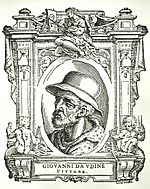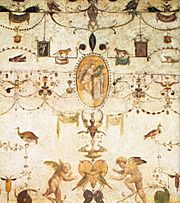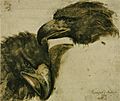Giovanni da Udine facts for kids
Giovanni Nanni, also known as Giovanni da Udine (1487–1564), was a talented Italian painter and architect. He was born in the city of Udine. He is famous for his amazing decorative artwork.
Contents
Biography of Giovanni da Udine
Working with Raphael
Giovanni da Udine began his art career as a student and helper to the famous artist Raphael. Giovanni was in charge of the "decorative" parts of Raphael's big projects in Rome. These were the parts that weren't storytelling, but rather beautiful designs.
He was very skilled at making fresco and stucco decorations. Fresco is painting on wet plaster. Stucco is a type of plaster that can be molded into shapes.
Famous Decorative Works
Giovanni created amazing stucco designs in the Loggia di Raffaello at the Vatican. This was done between 1517 and 1519. He also made the detailed fruit wreaths in the loggia di psiche at the Villa Farnesina. He even helped build large fountains, but these no longer exist. Giovanni was also known for his drawings of birds and fruit.
Rediscovering Stucco Art
The Discovery of Ancient Roman Art
One of Giovanni da Udine's most important contributions was rediscovering the art of stucco. Stucco is a special kind of plaster used for decoration. This happened after the discovery of the Domus Aurea. This was Emperor Nero's huge palace near the Colosseum in Rome.
In the early 1500s, Raphael and his students explored tunnels under a hill called Mons Coelius. They used candles and torches to see the walls. On these walls, they found small, brightly colored figures. These figures were called "grottesche" (meaning "from caves"). This name came from how they looked in the dark, like paintings in ancient caves.
Learning from Roman Stucco
They also found a strange "pictorial relief" where some of these "grottesche" were made. This was Roman stucco. The ancient Romans used this technique to make things look like real marble. Marble was very expensive, even for emperors. The Domus Aurea itself was a massive palace, covering a huge area.
Work After Raphael
After Raphael passed away, Giovanni da Udine kept working on projects his teacher had started. One of these was the Villa Madama in Rome. He continued his work until the sack of Rome (1527). This event caused him to leave Rome.
He then worked in Florence, where he created stucco designs in the New Sacristy at San Lorenzo. He also worked in Venice, adding stucco decorations to the Palazzo Grimani around 1540.
Projects in Udine and Cividale
In his hometown of Udine, Giovanni worked as an architect. He helped design the Torre dell'Orologio (Clock-Tower) and the Fontana di Piazza Nuova (Piazza Nuova Fountain). In Cividale, he helped build the Santa Maria dei Battuti.
Giovanni returned to Rome in 1560. There, he worked on the third floor of the Logge Vaticane. He died in Rome in 1564.
Gallery of Bird Drawings
See also
 In Spanish: Giovanni da Udine para niños
In Spanish: Giovanni da Udine para niños








